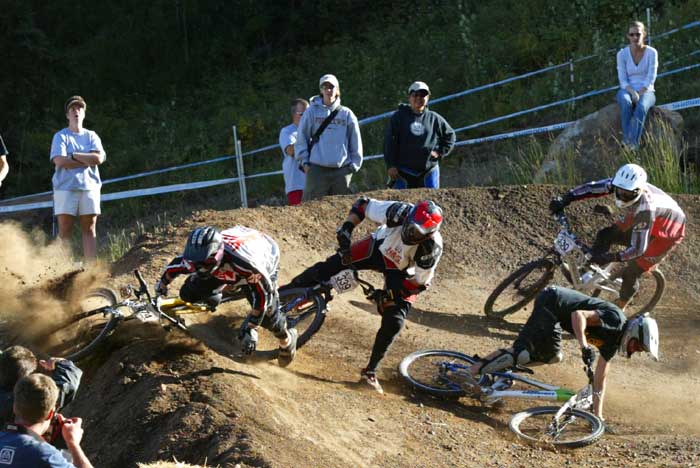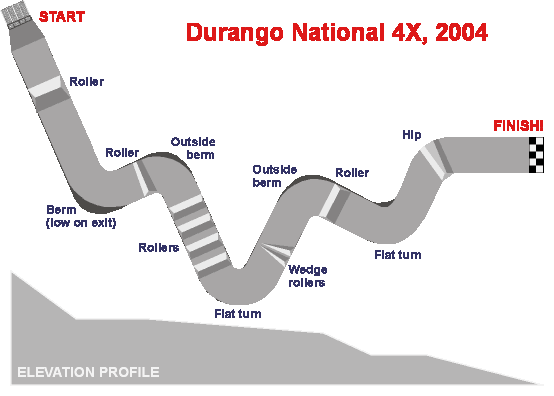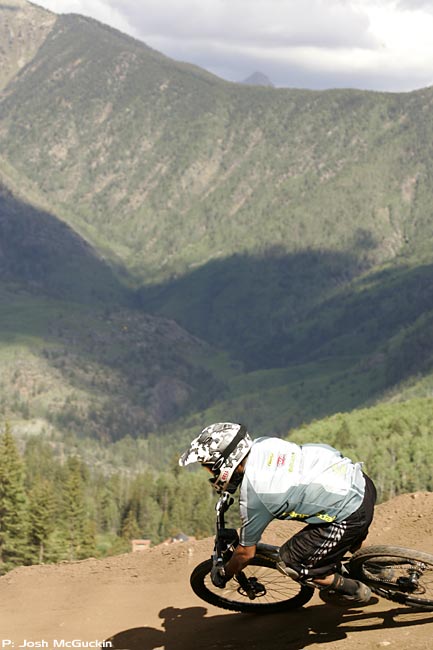
|
Posted August 31, 2004 Durango National Mountain Cross 
Forget the origin of the universe and the nature of man and all that stuff. The real question of this age is: What constitutes a good mountain cross course? This year's Durango course had a steep start with a roller, then a left berm, another roller, a flat right with a berm on the outside, a pack of four rollers, a flat left, a tiny wedge double, a flat right with a berm on the outside, a roller, a steep drop to a flat left, a flat run-up to a right hip, then a steep straight to the finish. There were no jumps of consequence, and it was hard to find flow. There was some back and forth in the flat corners, but most heats were decided in the first berm. Woe to you if you hole shotted; you were just a target. Smart riders got way ahead or hung back and weaved through the carnage. 
 The pro men's final contained to Eric Carter, Mike King, Rich Houseman and some guy named Brian Lopes. They finished in that order. The pro womens' final went Jill Kintner, Tara Llanes, Tracey Hannah then Leana Gerrard. There, now that that's out of the way, let's get to the nitty gritty.
The pro men's final contained to Eric Carter, Mike King, Rich Houseman and some guy named Brian Lopes. They finished in that order. The pro womens' final went Jill Kintner, Tara Llanes, Tracey Hannah then Leana Gerrard. There, now that that's out of the way, let's get to the nitty gritty.
When it came to the course itself, the racers did a lot of complaining and the builder did a lot of defending. Here are both sides of the argument, along with my opinion: The naysayers "This course isn't fun. There's no flow." Lopes and John Kirkaldie rolled up on cross country bikes and just shook their heads. Lamented the speedy Kiwi, "I really thought it would be good this time." "It should show off our skills." Meaning: It should have big jumps and complex rhythms. Everyone loved West Virgina this year (built by Mike Hartlove and Racers Edge). That course required 300 truckloads of dirt and will remain at the bike park. "This course would be perfect for RC cars." A dig at Greg Herbold's other hobby. The creator  Greg Herbold (H-Ball, HB) is a Durango fixture. A decade ago he was one of the fastest and most flamboyant gravity racers, and he's good enough at marketing himself to remain one of mountain biking's loudest voices. Go to the bike shop on Main and you'll see many of his jerseys on the wall, along with a huge poster of him cranking out of a turn and, next to that, one of his old Miyata hardtails -- full DH circa 1991 with the Tioga tension disc rear wheel, an early Rock Shox and the white Onza Porcupine tires. Yes, when you plug into Durango's mtb spirit, you plug into the still-thriving energy of H-Ball. When the nationals come to town and you need someone to build a mountain cross course, there's really only one choice: HB himself.
Greg Herbold (H-Ball, HB) is a Durango fixture. A decade ago he was one of the fastest and most flamboyant gravity racers, and he's good enough at marketing himself to remain one of mountain biking's loudest voices. Go to the bike shop on Main and you'll see many of his jerseys on the wall, along with a huge poster of him cranking out of a turn and, next to that, one of his old Miyata hardtails -- full DH circa 1991 with the Tioga tension disc rear wheel, an early Rock Shox and the white Onza Porcupine tires. Yes, when you plug into Durango's mtb spirit, you plug into the still-thriving energy of H-Ball. When the nationals come to town and you need someone to build a mountain cross course, there's really only one choice: HB himself.
After I listened to all the whining I walked up the where HB was re-packing a berm and asked for his side of the story: Lee: A lot of people are complaining about this course. What is your vision? What are you trying to accomplish? HB: "I build according to NORBA's guidelines. They want fewer jumps and more flat corners, for more passing. That's what I build. "It's hard to build out here. There are lots of rocks in the dirt. You have to work with the terraces. There are lots of pipes under the course. You have to build the course just for this race and have it gone before you leave. "There isn't much help. I basically volunteer my time. I've been working here a week and a half, and I have other things to do, you know." Lee: It seems like everyone says they can build better courses. Do riders offer to help? HB: "The riders complain, they say 'We can build something totally sick,' but nobody helps. I say come on out and let's see if your arms work as well as your mouths. NORBA isnt ruining this. It's the racers' faults." Lee: It seems like most riders, especially the pros, want to ride big gnarly courses with big jumps. HB: "This isn't dirt jumping. You can do that any day. This is mountain bike racing." What I think  I did not enjoy practicing this course by myself, but I had a great time dicing with my friends in practice. I almost skipped qualifying because I was more interested in DH and just wasn't into 4X. When my alarm went off Friday morning I only went out there because I'm Lee and I like bikes. Qualifying was semi-fun. I yawned through the course and took 7th in Expert 30-39.
I did not enjoy practicing this course by myself, but I had a great time dicing with my friends in practice. I almost skipped qualifying because I was more interested in DH and just wasn't into 4X. When my alarm went off Friday morning I only went out there because I'm Lee and I like bikes. Qualifying was semi-fun. I yawned through the course and took 7th in Expert 30-39.
Let's not forget that Durango is RAD! Check out that view. Photo by Josh McGuckin. Racing was super fun. In the first round I got gated, held back then scooted through a gap in the first berm. David, who got the hole shot, blew over the berm, and I won. In the semi I got gated again, passed once and chased for third. Done. Eliminated. it was good fun, though. I will always prefer dual slalom, but I must admit mountain cross is super exciting. Four racers roar off the line like a freight train, and all the randomness keeps you on your toes. Volunteering: We pay money to race. If this was our local session spot it would one thing, but we pay money and travel great distances for a race experience. When we show up, the courses should be ready to rock, especially at major nationals. I could see companies and teams pledging support as a way to improve courses and expose their people, but I just can't see most of the top pros sweeping a berm during amateur practice. Ross Milan, yes. Brian Lopes, no. Whining. Stop it! This is mountain bike racing. 1) Any course can be fun if you have the right attitude. If the features don't challenge you, go faster. If practice is boring, wait 'til you dice with three other characters.]. 2) Any course can improve your skills. 3) Most any course can provide good racing. The business model of mountain cross. Mountain cross courses cost money to build. Without money from outside sponsors, all revenue must come from entries. Ridership numbers are low. The reasons vary: Fear of contact, "lame courses," lack of interest. Either way, mountain cross is a money-losing proposition. Places that can build permanent courses (Snowshoe, Whistler) can get a return on their investments. Everyhwere else has to make enough money from one event to pay for everything. It's not working now. I see four basic options: 1) We get outside sponsorship money. Ha! 2) We volunteer to build courses and run races. 3) We pay $100 or more to race. 4) We accept that this event isn't viable, at least at the national level. We go back to slalom (if that will work) or we enjoy mountain cross at the local level with our bro's. I don't know whether 4X will survive, nor do I know the best way to save it. I'll keep asking smart people what they think and see what I can come up with. In the mean time, I'll hit the BMX track so I'm not such a chump out of the gate. Here are some photos by my man True Tourtillot. |
Home
|
|
Home Email Lee © 2004 Lee McCormack. All rights reserved. |